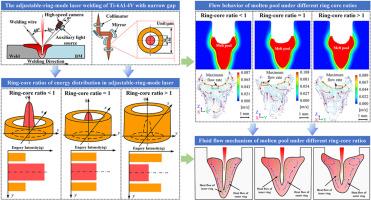Revealing internal flow behavior in adjustable-ring-mode laser welding of titanium alloys with a narrow gap structure
IF 5
2区 工程技术
Q1 ENGINEERING, MECHANICAL
International Journal of Thermal Sciences
Pub Date : 2025-10-01
DOI:10.1016/j.ijthermalsci.2025.110354
引用次数: 0
Abstract
Adjustable-ring-mode laser welding (ARMLW) combining both a ring beam and a central Gaussian beam has shown good advantages and feasibility in manufacturing narrow-gap high-performance components. However, the flow dynamics within the molten pool of ARMLW remain unclear. This study investigated thermal characteristics and flow dynamics in ARMLW of Ti-6Al-4V with narrow-gap structure, carrying out experiment and simulation. The results demonstrated that the ARM laser expanded effective heat source distribution, thereby enhancing molten metal flow and sidewall fusion. With the increase of ring-core ratio, the fusion zone at the sidewall gradually enlarged, and the concave angle of molten pool surface profile was increased from 0.87° to 1.31°. However, the flow velocities at both the surface and cross-sectional regions of the molten pool exhibited a non-monotonic trend. The maximum surface velocity of 3.941 m/s and mid-pool velocity of 0.108 m/s were obtained at a ring-core ratio of 1.29, where the fluid flow capacity in the inner sidewall fusion zone was significantly enhanced.Phenomenon above resulted from the peripheral circulation flow induced by the ring laser beam around molten pool, which significantly modified the hydrodynamic behavior of the liquid metal within the fusion zone. This study is anticipated to advance understanding of the phenomena involved in the ARMLW of titanium alloys with narrow gap structure, and further establish a fundamental basis for optimizing the narrow gap laser welding process.

窄间隙结构钛合金可调环模激光焊接内部流动特性研究
环形光束与中心高斯光束相结合的可调环模激光焊接(ARMLW)在制造窄间隙高性能器件方面显示出良好的优势和可行性。然而,ARMLW熔池内的流动动力学尚不清楚。本文对窄间隙结构Ti-6Al-4V的ARMLW的热特性和流动动力学进行了研究,并进行了实验和仿真。结果表明,ARM激光扩大了有效热源分布,从而增强了金属液流动和侧壁熔合。随着环芯比的增大,侧壁熔合区逐渐扩大,熔池表面轮廓凹角由0.87°增大到1.31°。熔池表面和横截面的流速均呈现非单调趋势。环芯比为1.29时,最大表面流速为3.941 m/s,池中流速为0.108 m/s,内侧壁融合区流体流动能力显著增强。上述现象是由于环形激光束在熔池周围引起的外围循环流动,显著地改变了熔池内液态金属的流体力学行为。本研究旨在促进对窄间隙结构钛合金ARMLW相关现象的认识,并进一步为窄间隙激光焊接工艺的优化奠定基础。
本文章由计算机程序翻译,如有差异,请以英文原文为准。
求助全文
约1分钟内获得全文
求助全文
来源期刊

International Journal of Thermal Sciences
工程技术-工程:机械
CiteScore
8.10
自引率
11.10%
发文量
531
审稿时长
55 days
期刊介绍:
The International Journal of Thermal Sciences is a journal devoted to the publication of fundamental studies on the physics of transfer processes in general, with an emphasis on thermal aspects and also applied research on various processes, energy systems and the environment. Articles are published in English and French, and are subject to peer review.
The fundamental subjects considered within the scope of the journal are:
* Heat and relevant mass transfer at all scales (nano, micro and macro) and in all types of material (heterogeneous, composites, biological,...) and fluid flow
* Forced, natural or mixed convection in reactive or non-reactive media
* Single or multi–phase fluid flow with or without phase change
* Near–and far–field radiative heat transfer
* Combined modes of heat transfer in complex systems (for example, plasmas, biological, geological,...)
* Multiscale modelling
The applied research topics include:
* Heat exchangers, heat pipes, cooling processes
* Transport phenomena taking place in industrial processes (chemical, food and agricultural, metallurgical, space and aeronautical, automobile industries)
* Nano–and micro–technology for energy, space, biosystems and devices
* Heat transport analysis in advanced systems
* Impact of energy–related processes on environment, and emerging energy systems
The study of thermophysical properties of materials and fluids, thermal measurement techniques, inverse methods, and the developments of experimental methods are within the scope of the International Journal of Thermal Sciences which also covers the modelling, and numerical methods applied to thermal transfer.
 求助内容:
求助内容: 应助结果提醒方式:
应助结果提醒方式:


